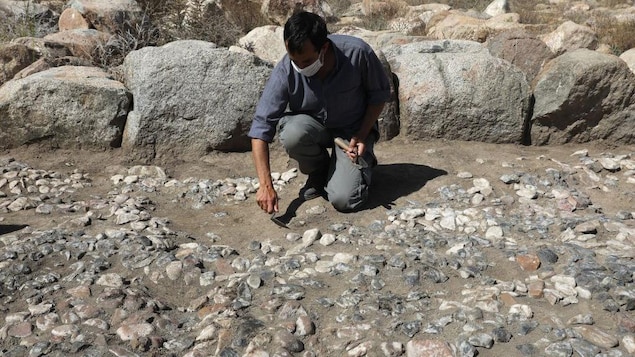This group of more than 3,000 stones in natural shades of beige, red and black, arranged in triangles and curves, was discovered in the ruins of a Hittite temple from the 15th century BC, 700 years before the oldest known mosaic of antiquity. Greece.
It is the ancestor of the ancient mosaic, which is clearly more developed. It can be said that what we have here is the first attempt to use this technique
, enthusiast Anaklito D’Agostino, director of excavation at Osakli Hoyuk, near Yozgat.
At this site three hours from Ankara, the Turkish capital, Turkish and Italian archaeologists use shovels and a brush to learn more about the Hittite sites, one of the most powerful kingdoms of ancient Anatolia.
For the first time, these people felt the need to do something different, with geometric shapes, and put colors together, rather than making a simple paving stone. Maybe the builder was a genius? Or he ordered a floor covering and decided to do something unusual
, he explains.
The temple that houses this mosaic is located opposite Mount Kerkenes, and is dedicated to Teshub, the storm god worshiped by the Hittites, the equivalent of Zeus among the Greeks.
This was probably where the Hittite priests performed their rituals while looking at the summit of Mount Kerkenes
Archaeologist says.
In addition to the mosaics, archaeologists have also discovered ceramics from one of the palaces, supporting the hypothesis that Osakli Hoyuk is indeed the lost city of Zibalanda.
A major place of worship dedicated to the storm deity, is regularly mentioned in the Hittite tablets, and the exact location of Zippalanda remains obscure to this day.
Researchers agree that Usakli Hoyuk is one of the most likely sites. With the discovery of the palace’s remains and its luxurious ceramic and glasswork, this possibility has been strengthened. We just need the ultimate guide: a city-name tablet
, says Mr. D’Agostino.
The treasures of Osakley Hoyuk, whose inhabitants did not hesitate to bring the cedars of Lebanon to build their temples and palaces, were swallowed up like the rest of the Hittite world, for a reason still unknown, towards the end of the century. Bronze Age.
Among the hypotheses of this collapse, that climate change accompanied by social unrest.
Nearly 3,000 years after their disappearance from the face of the earth, the Hittites still inhabit the imagination of the Turks.
A Hittite figure representing the sun is the symbol of Ankara. In the 1930s, the founder of modern Turkey, Mustafa Kemal Ataturk, presented the Turks as direct descendants of the Hittites.
I don’t know if we can find a connection between the Hittites and the people who live here today. Thousands of years passed and people moved. But I like to imagine that there is some kind of spiritual connection there.
As if to honor this connection, the excavation team reconstructed Hittite culinary traditions, experimenting with ancient recipes on similarly made ceramics, using the technique and clay used at the time.
We reconstructed the Hittite ceramics with the mud of the village where the site is located: we baked dates and bread on them, as the Hittites ate.
, said Valentina Orsi, co-director of excavations.
And it was very good
, specify.

“Extreme twitteraholic. Passionate travel nerd. Hardcore zombie trailblazer. Web fanatic. Evil bacon geek.”



